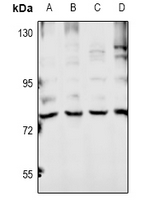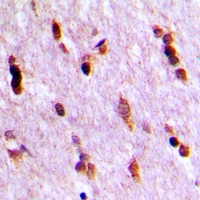Anti-Ubiquilin 4 Antibody
Rabbit polyclonal antibody to Ubiquilin 4
- 产品详情
- 实验流程
- 背景知识
Application
| WB, IHC |
|---|---|
| Primary Accession | Q9NRR5 |
| Other Accession | Q99NB8 |
| Reactivity | Human, Mouse, Rat |
| Host | Rabbit |
| Clonality | Polyclonal |
| Calculated MW | 63853 Da |
| Gene ID | 56893 |
|---|---|
| Other Names | C1orf6; CIP75; UBIN; Ubiquilin-4; Ataxin-1 interacting ubiquitin-like protein; A1Up; Ataxin-1 ubiquitin-like-interacting protein A1U; Connexin43-interacting protein of 75 kDa; CIP75 |
| Target/Specificity | KLH-conjugated synthetic peptide encompassing a sequence within the center region of human Ubiquilin 4. The exact sequence is proprietary. |
| Dilution | WB~~WB (1/500 - 1/1000), IHC (1/100 - 1/200) IHC~~WB (1/500 - 1/1000), IHC (1/100 - 1/200) |
| Format | Liquid in 0.42% Potassium phosphate, 0.87% Sodium chloride, pH 7.3, 30% glycerol, and 0.09% (W/V) sodium azide. |
| Storage | Store at -20 °C.Stable for 12 months from date of receipt |
| Name | UBQLN4 {ECO:0000303|PubMed:27113755, ECO:0000312|HGNC:HGNC:1237} |
|---|---|
| Function | Regulator of protein degradation that mediates the proteasomal targeting of misfolded, mislocalized or accumulated proteins (PubMed:15280365, PubMed:27113755, PubMed:29666234, PubMed:30612738). Acts by binding polyubiquitin chains of target proteins via its UBA domain and by interacting with subunits of the proteasome via its ubiquitin-like domain (PubMed:15280365, PubMed:27113755, PubMed:30612738). Key regulator of DNA repair that represses homologous recombination repair: in response to DNA damage, recruited to sites of DNA damage following phosphorylation by ATM and acts by binding and removing ubiquitinated MRE11 from damaged chromatin, leading to MRE11 degradation by the proteasome (PubMed:30612738). MRE11 degradation prevents homologous recombination repair, redirecting double-strand break repair toward non-homologous end joining (NHEJ) (PubMed:30612738). Specifically recognizes and binds mislocalized transmembrane-containing proteins and targets them to proteasomal degradation (PubMed:27113755). Collaborates with DESI1/POST in the export of ubiquitinated proteins from the nucleus to the cytoplasm (PubMed:29666234). Also plays a role in the regulation of the proteasomal degradation of non-ubiquitinated GJA1 (By similarity). Acts as an adapter protein that recruits UBQLN1 to the autophagy machinery (PubMed:23459205). Mediates the association of UBQLN1 with autophagosomes and the autophagy-related protein LC3 (MAP1LC3A/B/C) and may assist in the maturation of autophagosomes to autolysosomes by mediating autophagosome-lysosome fusion (PubMed:23459205). |
| Cellular Location | Nucleus. Cytoplasm. Chromosome Endoplasmic reticulum {ECO:0000250|UniProtKB:Q99NB8}. Cytoplasm, perinuclear region {ECO:0000250|UniProtKB:Q99NB8}. Cytoplasmic vesicle, autophagosome. Note=Colocalizes with the proteasome, both in nucleus and cytoplasm (PubMed:15280365). Exported from the nucleus following interaction with DESI1/POST (PubMed:29666234). In response to DNA damage and phosphorylation at Ser-318 by ATM, localizes to the nucleus and is recruited to sites of DNA damage (PubMed:30612738). |
| Tissue Location | Highly expressed in pancreas, kidney, skeletal muscle, heart and throughout the brain, and at lower levels in placenta, lung and liver. |
Research Areas
For Research Use Only. Not For Use In Diagnostic Procedures.
Application Protocols
Provided below are standard protocols that you may find useful for product applications.
BACKGROUND
KLH-conjugated synthetic peptide encompassing a sequence within the center region of human Ubiquilin 4. The exact sequence is proprietary.
终于等到您。ABCEPTA(百远生物)抗体产品。
点击下方“我要评价 ”按钮提交您的反馈信息,您的反馈和评价是我们最宝贵的财富之一,
我们将在1-3个工作日内处理您的反馈信息。
如有疑问,联系:0512-88856768 tech-china@abcepta.com.























 癌症的基本特征包括细胞增殖、血管生成、迁移、凋亡逃避机制和细胞永生等。找到癌症发生过程中这些通路的关键标记物和对应的抗体用于检测至关重要。
癌症的基本特征包括细胞增殖、血管生成、迁移、凋亡逃避机制和细胞永生等。找到癌症发生过程中这些通路的关键标记物和对应的抗体用于检测至关重要。 为您推荐一个泛素化位点预测神器——泛素化分析工具,可以为您的蛋白的泛素化位点作出预测和评分。
为您推荐一个泛素化位点预测神器——泛素化分析工具,可以为您的蛋白的泛素化位点作出预测和评分。 细胞自噬受体图形绘图工具为你的蛋白的细胞受体结合位点作出预测和评分,识别结合到自噬通路中的蛋白是非常重要的,便于让我们理解自噬在正常生理、病理过程中的作用,如发育、细胞分化、神经退化性疾病、压力条件下、感染和癌症。
细胞自噬受体图形绘图工具为你的蛋白的细胞受体结合位点作出预测和评分,识别结合到自噬通路中的蛋白是非常重要的,便于让我们理解自噬在正常生理、病理过程中的作用,如发育、细胞分化、神经退化性疾病、压力条件下、感染和癌症。







